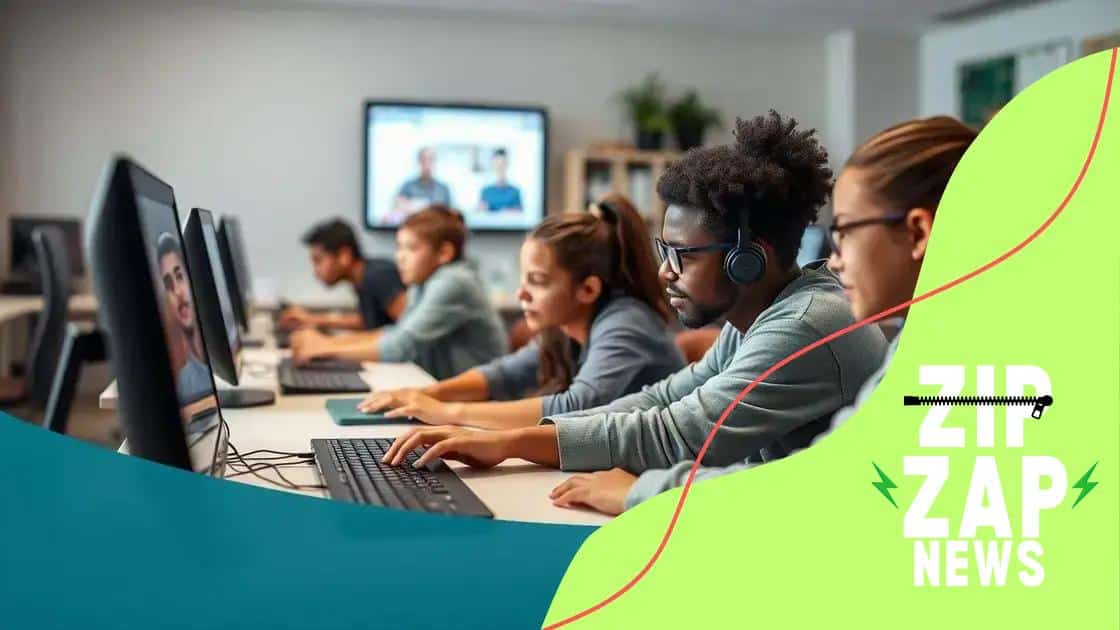The impact of virtual classrooms on student collaboration

The impact of virtual classrooms on student collaboration is profound, enhancing engagement, communication, and teamwork through interactive tools and personalized learning approaches.
The impact of virtual classrooms on student collaboration is significant, reshaping how students work together. Have you considered how this new environment encourages engagement and teamwork? Let’s dive into the details.
Overview of virtual classrooms
Virtual classrooms have transformed the way students learn and interact. In these online environments, students can connect from anywhere, making education more accessible than ever. It’s exciting to see how technology reshapes traditional learning.
Key Features of Virtual Classrooms
There are several crucial elements that make virtual classrooms effective:
- Interactive Tools: Features like chat, video, and shared documents enhance student engagement.
- Flexibility: Students can learn at their own pace, fitting education into their lives more easily.
- Collaboration: These platforms encourage cooperative learning through group projects and discussions.
Accessibility is another vital aspect. With virtual classrooms, students can participate in lessons from remote locations, breaking down geographic barriers. This accessibility enables a diverse learning experience, as students from different backgrounds and areas come together to share ideas.
Benefits of Engaging in Virtual Classrooms
When students engage in a virtual classroom, they reap numerous benefits:
- Enhanced Communication: Real-time communication with peers and instructors fosters a sense of community.
- Resource Availability: Students can access a myriad of online resources to aid their learning process.
- Personal Growth: Navigating technological platforms boosts digital literacy and self-discipline.
This new way of learning not only enhances academic achievements but also prepares students for a tech-savvy world. In conclusion, the rise of virtual classrooms signifies a significant shift in education, offering unique opportunities for collaboration and growth.
Benefits of collaborative tools
Collaborative tools are essential in a virtual classroom. They not only enhance learning but also foster teamwork among students. This modern approach to education encourages active participation and communication.
Key Advantages of Collaborative Tools
Using these tools can significantly improve the educational experience. Here are some important benefits:
- Improved Engagement: Students are more likely to participate when using interactive tools that involve them in the learning process.
- Real-time Feedback: Instructors can provide instant feedback, helping students understand concepts better and faster.
- Enhanced Creativity: Collaboration sparks new ideas, encouraging students to think outside the box and learn from each other.
Working together through collaborative tools also builds important soft skills. Students learn how to communicate effectively, manage conflicts, and share responsibility for their work. These skills are vital for their future careers.
Specific Tools and Their Functions
Several types of collaborative tools can be used in a virtual classroom. Some popular options include:
- Discussion Forums: Allow students to discuss topics in depth, promoting critical thinking.
- Group Projects: Enable students to work together, divide tasks, and learn time management.
- Document Sharing: Facilitate real-time editing and sharing of information, making collaboration seamless.
These features help create a rich learning experience, where students feel connected and supported by their peers. Ultimately, the integration of collaborative tools in virtual classrooms enhances both academic performance and personal growth.
Strategies for effective student interaction

Effective student interaction is crucial in virtual classrooms. Implementing the right strategies can enhance the learning experience and promote collaboration among peers. This ensures that students feel connected and engaged in their studies.
Fostering Communication
Encouraging open communication is essential. Teachers can create a welcoming environment for students to express their thoughts. This can be achieved through:
- Video Discussions: Engaging students in video calls allows for face-to-face interaction.
- Chat Platforms: Using chat features lets students ask questions and share ideas in real-time.
- Virtual Office Hours: Offering specific times when students can reach out fosters support and guidance.
All these communication methods encourage collaboration and help students feel like they are part of a community. These interactions develop relationships that are beneficial for group projects and discussions.
Group Activities and Peer Learning
Implementing group activities is another effective strategy. Working together on projects helps students learn from one another. Collaborative activities can include:
- Team Projects: Assigning students to work in teams to complete tasks cultivates teamwork skills.
- Peer Review Sessions: Allowing students to give feedback on each other’s work enhances critical thinking.
- Breakout Rooms: Creating smaller groups within virtual classrooms enables focused discussions.
These group interactions motivate students to participate actively. Furthermore, they encourage problem-solving and critical thinking, preparing students for real-world scenarios.
Utilizing Technology
Integrating technology is vital for enhancing student interaction. Platforms with interactive features can improve engagement. Some effective tools are:
- Interactive Whiteboards: These allow students to contribute ideas visually, making learning more dynamic.
- Polls and Quizzes: Engaging students with quick checks for understanding keeps them attentive.
- Gamification: Incorporating game elements motivates students to participate and compete in a healthy way.
Using these tools keeps lessons fresh and exciting, which is essential for maintaining student interest and involvement in their learning journeys. By applying these strategies, instructors can effectively enhance student interaction in virtual classrooms.
Challenges of virtual collaboration
Collaboration in a virtual classroom is not without its challenges. While technology offers many benefits, students and educators may encounter obstacles that hinder effective interaction. Recognizing these challenges is the first step toward overcoming them.
Technical Difficulties
One of the most common issues in virtual collaboration is technical problems. Internet connectivity can be unreliable, leading to frustration for both students and teachers. In addition, software glitches may disrupt classes, impacting the overall learning experience. Some students may not have access to the latest devices, creating a gap in participation.
Communication Barriers
Effective communication is essential in virtual collaboration. However, students may struggle to express their ideas clearly through digital means. Misunderstandings can arise more easily without non-verbal cues, such as body language and facial expressions. Instructors must take extra care to ensure that messages are understood.
Engagement Challenges
Maintaining student engagement in an online environment can be difficult. Students might feel isolated or distracted by their surroundings. The absence of a physical classroom atmosphere can reduce motivation to participate actively. To foster engagement, instructors need to implement various strategies that encourage participation.
Team Dynamics
Collaboration often requires balancing different personalities and work styles. In virtual classrooms, these dynamics can become more complicated. Some students may dominate discussions while others struggle to contribute. Establishing clear roles and responsibilities can help mitigate these issues, helping everyone work towards common goals.
While challenges in virtual collaboration exist, many solutions can be implemented to enhance interaction and learning outcomes. By addressing technical issues, improving communication, boosting engagement, and managing team dynamics, educators can create a more effective collaborative environment.
Future trends in online education
The future of online education is promising and exciting. As technology evolves, so does the way students learn in virtual classrooms. Several trends are beginning to shape this field, making education more accessible and engaging.
Personalized Learning Experiences
One significant trend is the rise of personalized learning. This approach allows students to learn at their own pace, addressing individual needs and preferences. With adaptive learning technologies, courses can adjust based on a student’s performance. This customization empowers learners by tailoring content to their unique requirements.
Increased Use of Artificial Intelligence
Another growing trend in online education is the use of artificial intelligence (AI). AI can automate administrative tasks, provide data analysis, and offer personalized feedback to students. Tools powered by AI can assist educators in identifying students who may need extra help. This technology can enhance interactions between students and instructors, making the learning process more efficient.
Enhanced Virtual Reality and Augmented Reality
Virtual reality (VR) and augmented reality (AR) are beginning to transform online learning environments. These immersive technologies offer students experiences that go beyond traditional learning. For instance, students can explore historical events or scientific concepts in a simulated space. These hands-on experiences enhance understanding and retention of information.
Flexible Learning Formats
The demand for flexibility is driving the creation of various learning formats. Online education is becoming more hybrid, combining synchronous and asynchronous methods. Students can choose to attend live classes or access recorded sessions based on their schedules. This flexibility supports diverse learning styles and enables a more inclusive education system.
As these trends unfold, they are likely to continue shaping the future of online education. By embracing innovations and adapting to these changes, educators can create enriching learning environments that meet the needs of a broad range of students.
FAQ – Questions About the Impact of Virtual Classrooms on Student Collaboration
How do virtual classrooms enhance student collaboration?
Virtual classrooms use technology to create interactive and engaging environments where students can easily communicate and collaborate on projects.
What are the main challenges of collaborating in virtual classrooms?
Challenges include technical difficulties, communication barriers, and maintaining student engagement, which can affect collaboration effectiveness.
What tools can improve interaction among students?
Tools like discussion forums, video conferencing, and collaborative document editing enhance communication and make working together easier.
How does personalized learning benefit students in virtual classrooms?
Personalized learning tailors educational experiences to individual student needs, allowing them to learn at their own pace and improving overall engagement.





